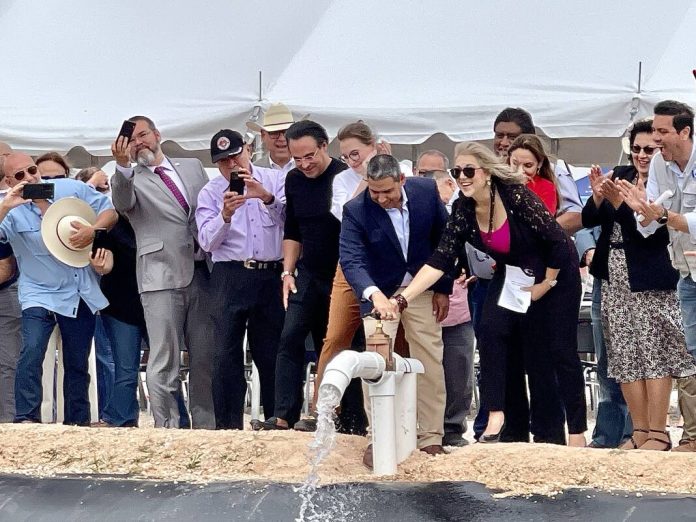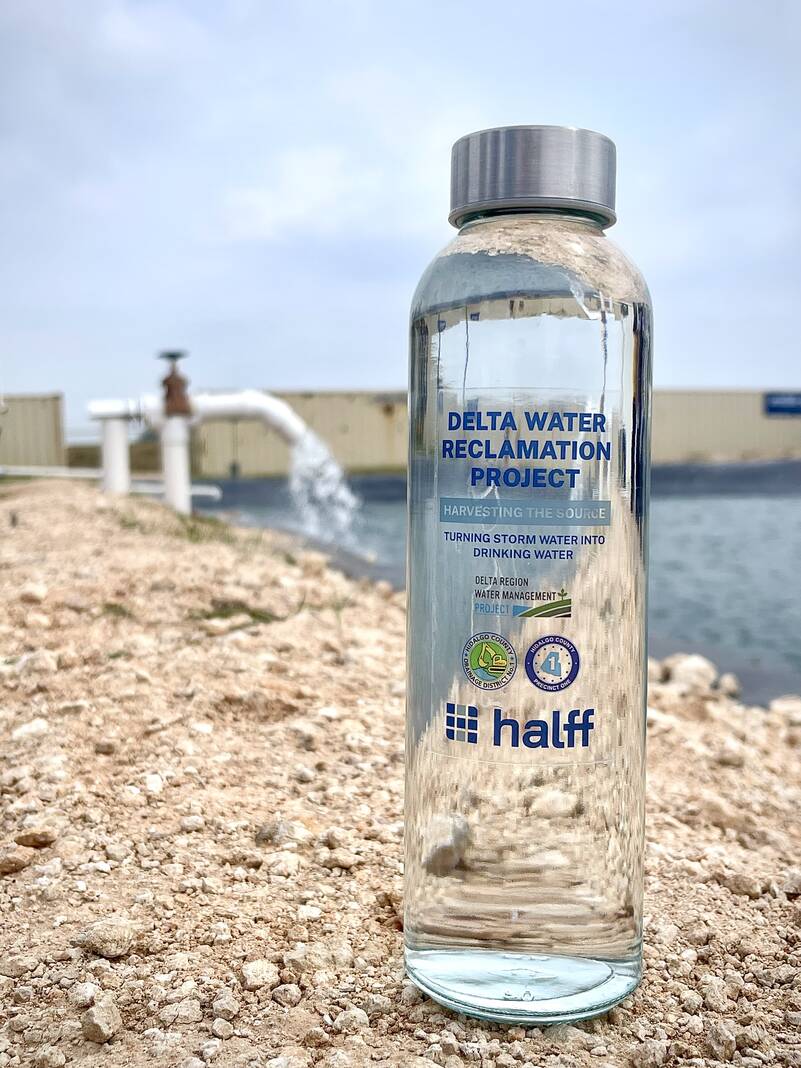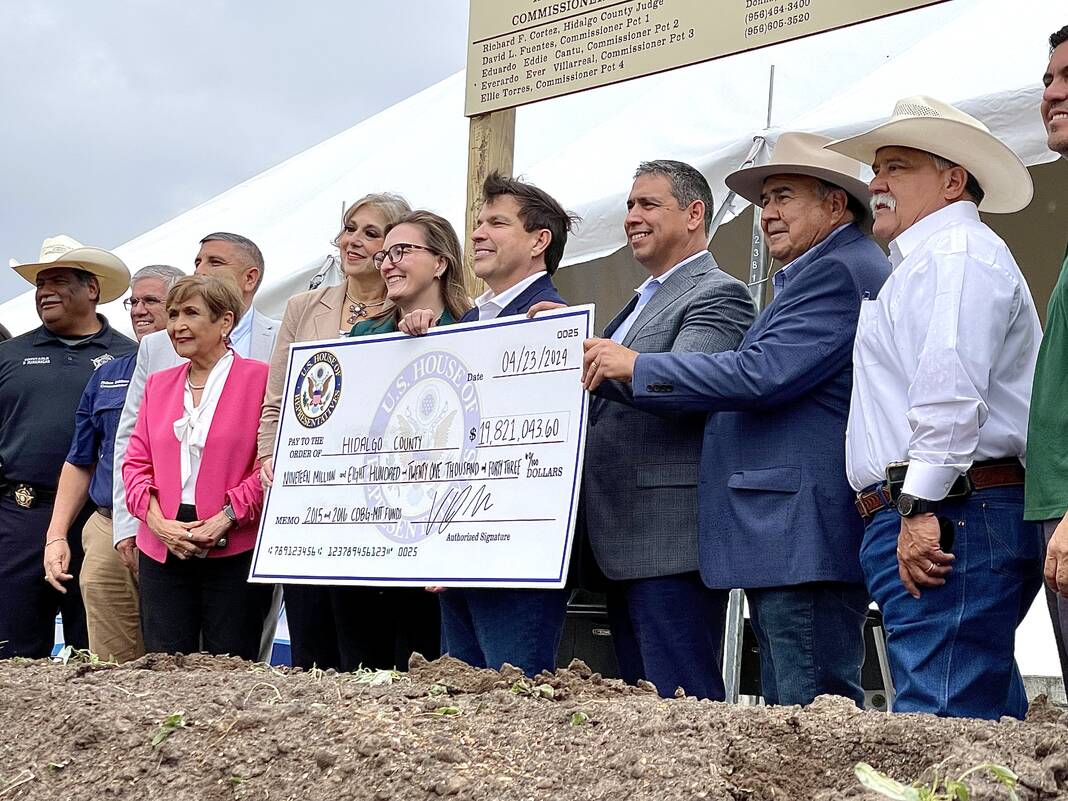
|
Only have a minute? Listen instead |
LA VILLA — Years in the making. That’s how officials described two major infrastructure projects that were unveiled in eastern Hidalgo County this week.
“Back in 2017, we talked about this project and it’s taken that long to get to this point,” Hidalgo County Precinct 1 Commissioner David Fuentes said Thursday morning.
Fuentes was speaking of a first-of-its-kind project for the state of Texas — a water reclamation facility that will one day be able to take stormwater runoff and turn it into safe drinking water.
Fuentes said he first got the idea for the project after he and other officials paid a visit to Santa Monica, California to learn how that often drought-stricken state deals with water scarcity.
As he stood on a small stage that had been erected at the corner of a dusty, 225-acre tract of land accessible only by a bumpy trek down a lonely dirt road at the point where Hidalgo and Willacy counties meet, Fuentes’ mood was triumphant.
Though located in the most rural stretch of the county, the project will nonetheless have an impact that far outstretches its physical footprint.
Not only will the facility, dubbed the Delta Water Reclamation Project, serve to safeguard Hidalgo County communities in times of flood, but it will also help protect communities further downstream — those in Willacy and Cameron County.
“The primary purpose was for flood mitigation,” Fuentes said of how the project first began as a plan to build a massive detention pond.
“We would be able to pull water out, store it, hold it, manage it, and then bleed it back into the system so that we could help control waters not just in our North Main Drain … but also helping our neighbors to the east,” Fuentes said.
But soon, the plan for the site became what another local official described as a “vision that redesigns the landscape of stormwater management in our region.”
“Think about this: to capture and treat water from a major Hidalgo County drainage outfall channel and be able to unlock a brand new water source for the region, it’s amazing!,” Hidalgo County Precinct 4 Commissioner Ellie Torres said during Thursday’s event.
After the conclusion of Thursday’s remarks, Torres and Fuentes would go on to ceremoniously open a water valve at the reclamation site to celebrate its future as a new water source.
But while addressing the crowd of local dignitaries who attended the event, Torres said the facility’s development could not have come at a more opportune moment.
“This innovative project comes at a critical time for the Rio Grande Valley in the midst of disaster drought declarations across Texas,” she said.

Indeed, just last week, the Hidalgo County Commissioners’ Court voted unanimously to extend a drought disaster declaration initially issued by Hidalgo County Judge Richard F. Cortez.
Cameron County Judge Eddie Treviño in April also renewed the county’s drought disaster declaration as well.
Cortez declared a local state of disaster in the wake of Mexico’s continued noncompliance with a 70-year-old water sharing treaty with the U.S.
That treaty obligates Mexico to release water from six tributary waterways into the Rio Grande, where it can be stored in the region’s two international reservoirs.
But Mexico is years behind in making the water deliveries, leaving the two reservoirs at a combined storage level of about 21%.
Last week, the Texas Commission on Environmental Quality, or TCEQ, issued a letter to Valley water suppliers warning them that things have become so dire that regular water conservation measures may no longer be enough to thwart water scarcity.
“Without significant reduction in demand through water conservation, critical water shortages could develop,” the letter, dated April 15, reads, in part.
The reclamation facility is still several years away from being able to produce water that can be used by end users, like residents and businesses.
Within the next month, Fuentes said testing data from the pilot facility will be sent to TCEQ for analysis. If approved, the project will be able to move one step closer to full-scale reality.
Nevertheless, he hopes it will one day serve to insulate the region from issues like binational water worries.
“This provides a lot of that water resource that we need right now, that we are desperate for in this drought situation, in our declaration of disaster right now because of that lack of water,” Fuentes said.
If the Delta Reclamation project is successful, Fuentes has plans to build two more such facilities elsewhere in Hidalgo County, and to partner with officials in Willacy County for another.
All together, the four reclamation facilities could one day provide enough potable water to supply 20,000 homes, he said.
But Thursday’s reclamation project wasn’t the only one Fuentes and other local leaders celebrated this week.
On Tuesday, officials from Hidalgo, Cameron and Willacy counties were joined by state lawmakers, as well as U.S. Rep. Vicente Gonzalez, D-Brownsville, to usher in development on a $20 million expansion of the North Main Drain system.

Though located entirely in Hidalgo County, the Main Drain system — and its subsystems, the North Main Drain and the South Main Drain — are integral systems that take floodwaters that originate as far away as Starr County and carry it to outfalls in the Laguna Madre.
“This is just one project of many that are being looked at that are all interwoven together so that we can all plan mutually, beneficially, and at the same time, help our local communities,” Cameron County Precinct 3 Commissioner David Garza said on Tuesday morning.
Garza called the project, and others like it, “critically important” because of their regional impacts.
“Everything flows east, as we all know,” he said.
For Gonzalez, who worked to secure the funding as part of federal disaster relief monies Congress approved in response to severe flooding events in 2015 and 2016, it’s important to be proactive, rather than reactive, to disaster.
“I always tell the folks in Washington, you either help us fix our problems today, or you’ll pay for devastation tomorrow,” Gonzalez said after Tuesday’s drainage groundbreaking ceremony north of Edcouch.
Back at the reclamation facility ceremony, state lawmakers also lauded the regional infrastructure efforts.
In particular, state Rep. Terry Canales, D-Edinburg, spoke of how the water reclamation idea was so novel that he and other state lawmakers had to figure out how to approach it legislatively.
“It lacked the legislative framework. We didn’t know how to do it legally,” Canales said.
It’s something Fuentes speaks of often, as well.
Since no other potable water reclamation facilities exist in the state, the innovative project largely falls outside of funding guidelines that have been established for more traditional projects, like expanding a drainage ditch or building a new water treatment facility — things the state already regularly provides funding for.
Unlike the Main Drain expansion, which is being funded through federal grants, the Delta Reclamation project is, thus far, being funded by monies from two bond elections approved by Hidalgo County Drainage District No. 1 voters.
Some $50 million from bond elections voters approved in 2019 and 2023 have been earmarked for the project.
The reclamation project is so important that state lawmakers brought Dade Phelan, Speaker of the Texas House of Representatives, down to the Valley to understand it firsthand.
“Water is life and we have to focus as a region on the future of water,” Canales said. “We talk a lot about border security, I think we need to start talking about water security.”

